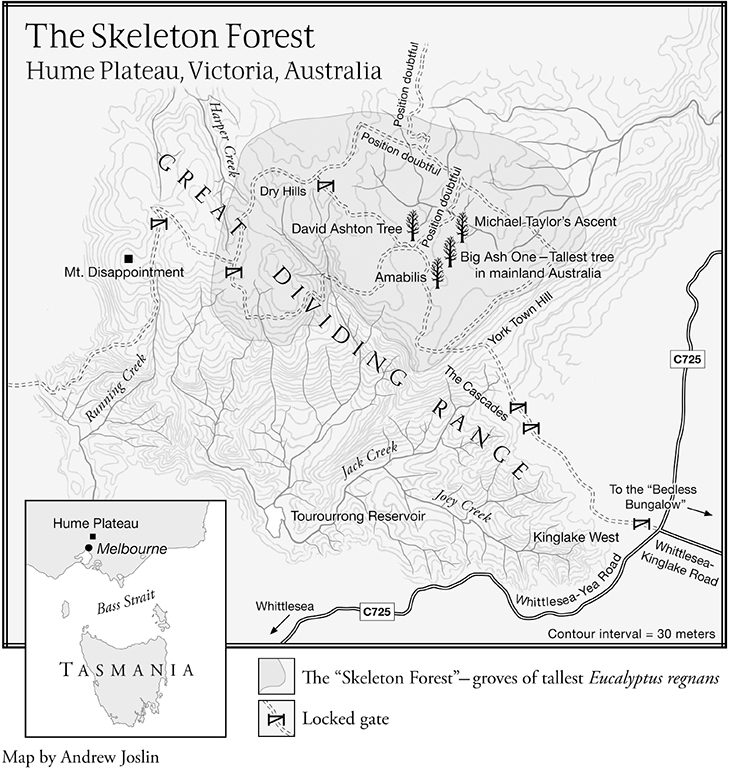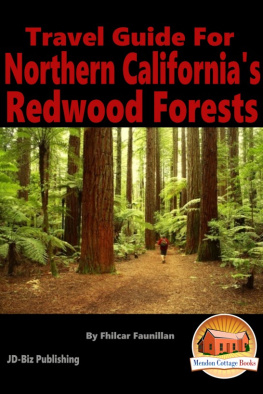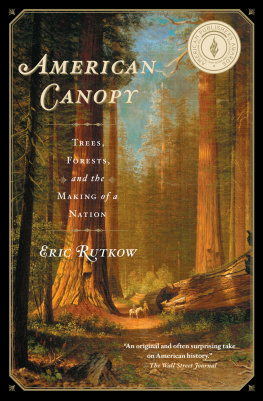

CONTENTS
1
Vertical Eden
2
The Fall of Telperion
3
The Opening of the Labyrinth
4
Love in Zeus
5
Into the Deep Canopy
To my brother Douglas Preston
Remember that tree we used to climb when we were boys?
Those who dwell among the beauties and mysteries of the earth are never alone or weary of life.
R ACHEL C ARSON
AUTHORS NOTE
This book is narrative nonfiction. The characters are real and the events are factual, told to the best of my understanding. Passages in which I narrate a persons thoughts and feelings and present dialogue have been built from interviews with the subjects and witnesses, and have been fact-checked. So many incredible things happen in our world that are never noticed, so many stories never get told. My goal is to reveal people and realms that nobody had ever imagined.
R ICHARD P RESTON, 2007
M APS AND I LLUSTRATIONS
BY
A NDREW J OSLIN
OF BOTANISTS AND TREES
Botanists have a tradition of never revealing the exact location of a rare plant. Contact between humans and rare plants is generally risky for the plants. Many of the giant trees I describe in this book, as well as the groves they inhabit, have only recently been discovered, and in some cases have been seen by fewer than a dozen people, including myself. To honor the tradition of botany, I wont reveal the exact locations of giant trees or groves if these locations have not been previously published. If a trees location has been published, or if the tree is no longer alive, then I will give its location.




NAMELESS
O NE DAY IN THE MIDDLE OF O CTOBER 1987, A BABY-BLUE Honda Civic with Alaska license plates, a battered relic of the seventies, sped along the Oregon Coast Highway, moving south on the headlands. Below the road, surf broke around sea stacks, filling the air with haze. The car turned in to a deserted parking lot near a beach and stopped.
A solid-looking young man got out from the drivers side. He had brown hair that was going prematurely gray, and he wore gold-rimmed spectacles, which gave him an intellectual look. His name was Marwood Harris, and he was a senior at Reed College, in Portland, majoring in English and history. He walked off to the side of the parking lot and unzipped his fly. There was a splashing sound.
Meanwhile, a thin, tall young man emerged from the passenger side of the car. He had a bony face, brown eyes, and a mop of sun-streaked brown hair, and he wore a pair of bird-watching binoculars around his neck. Scott Sillett was a junior at the University of Arizona, twenty-one years old, visiting Oregon during fall break. He took up his binoculars and began to study a flock of shorebirds running along the surf.
The interior of the Honda Civic was made of blue vinyl, and the back seat was piled with camping gear that pressed up against the windows. The pile of stuff moved and a leg emerged, followed by a curse, and a third young man struggled out and stood up. Mardiddy, this car of yours is going to be the death of us all, he said to Marwood Harris. He was Stephen C. Sillett, the younger brother of Scott Sillett. Steve Sillett was nineteen and a junior at Reed College, majoring in biology. He was shorter and more muscular than his older brother. Steve Sillett had feathery light-brown hair, which hung out from under a sky-blue bandanna that he wore tied around his head like a cap. He had flaring shoulders, and his eyes were dark brown and watchful, and were set deep in a square face. The Sillett brothers stood shoulder to shoulder, looking at the birds. Their bodies were outlined against decks of autumn rollers coming in, giving off a continual roar. Scott handed the binoculars to his younger brother, and their hands touched for an instant. The Sillett brothers hands had the same appearancefine and sensitive-looking, with deft movements.
Scott turned to Marwood: Marty, I think your car should be called the Blue Vinyl Crypt. Thats what it will turn into if we fall off a cliff or get swiped by a logging truck.
Dude, youre going to get us into a crash that will be biblical in its horror, Steve said to Marwood. You need to let Scott drive. (Steve didnt know how to drive a car.)
Marwood didnt want Scotts help with the driving. Its a very idiosyncratic car, he explained to the Sillett brothers. In theory, he fixed his car himself. In practice, he worried about it. Lately Marwood had noticed that the engine had begun to give off a clattering sound, like a sewing machine. He had also become aware of an ominous smell coming from under the hood, something that resembled the smell of an empty iron skillet left forgotten on a hot stove. As Marwood contemplated these phenomena and pondered their significance, he wondered if his car needed an oil change. He was fairly sure that the oil had been changed about two years ago, in Alaska, around the time the license plates had expired. The car had been driven twenty thousand miles since then, unregistered, uninsured, and un-maintained, strictly off the legal and mechanical grids. Im worried youll screw it up, he said to Scott.
Steve handed the binoculars to his older brother and climbed into the back of the Blue Vinyl Crypt. Dudes, lets go, he said. We need to see some tall redwoods.
They planned to go backpacking in one of the small California state parks that contain patches of ancient coast redwood forest. None of the young men had ever seen a redwood forest. Steve seemed keyed up.
T HE COAST REDWOOD TREE IS AN EVERGREEN CONIFER AND A MEMBER of the cypress family. Its scientific name is Sequoia sempervirens. It is sometimes called the California redwood, but most often it is simply referred to as the redwood. No one knows exactly when or where the redwood entered the history of life on earth, though it is an ancient kind of tree, and has come down to our world as an inheritance out of deep time. A redwood has furrowed, fibrous bark, and a tall, straight trunk. It has soft, flat needles that become short and spiky near the top of the tree. The tree produces seeds but does not bear flowers. The seeds of a redwood are released from cones that are about the size of olives. The heartwood of the tree is a dark, shimmery red in color, like old claret. The wood has a lemony scent, and is extremely resistant to rot.
Redwoods grow in valleys and on mountains along the coast of California, mostly within ten miles of the sea. They reach enormous sizes in the mild, rainy climate of the northern stretches of the coast. Parts of the North Coast of California are covered with temperate rain forest. A rain forest is usually considered to be a forest that gets at least eighty inches of rain a year, and parts of the North Coast get more than that. A temperate rain forest has a cool, moist, even climate, not too hot or cold. Redwoods flourish in fog, but they dont like salt air. They tend to appear in valleys that are just out of sight of the sea. In their relationship with the sea, redwoods are like cats that long to be stroked but are shy to the touch. The natural range of the coast redwoods begins at a creek in Big Sur that flows down a mountain called Mount Mars. From there, the redwoods run up the California coast in a broken ribbon, continuing to just inside Oregon. Fourteen miles up the Oregon coast, in the valley of the Chetco River, the redwoods stop.
Next page






















